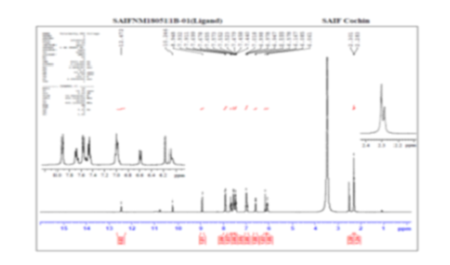


Indian Journal of Science and Technology
Year: 2021, Volume: 14, Issue: 34, Pages: 2731-2741
Original Article
Valarmathy Govindaraj1*, Subbalakshmi Ramanathan1, Nithya Rajendran1, Nandhini Ragu1, Sabarika Balachandaran1, Aarthy Elanchleiyan1
1PG and Research, Department of Chemistry, Seethalakshmi Ramaswami College, Affiliated to Bharathidasan University, Tiruchirappalli, 620002, Tamil Nadu, India
*Corresponding Author
Email: [email protected]
Received Date:21 May 2021, Accepted Date:15 September 2021, Published Date:20 October 2021
Objectives: To synthesize Schiff bases i.e 4-((2-hydroxybenzylidene)-amino–N-(5-methyl-1,2-oxozol-3- yl)benzene sulphonamide (L1), 4-((2-hydroxy benzylidene)-amino-N-(thiazol-yl)benzene sulphonamide (L2), 4-((2-hydroxybenzylidene)amino-N-(pyridin-2-yl)benzene sulphonamide by theaction of 2-hydroxybenzaldehyde with sulfathiazole/ sulfamethoxazole/ sulfapyridine in ethanolic media. Methods: The Schiff bases obtained were characterized by analytical data, IR, UV, 1H- NMR, 13C-NMR, Mass spectrum and monitored for cytotoxic activity against human breast cancer cell [MDA MB -231] line. Findings: The Schiff bases behaves as a bidentate ligand with oxygen and nitrogen as chelating positions and coordinates via phenolic oxygen and azomethine nitrogen. The composition of the ligands has been established by elemental analysis. Structural features and bonding mode of the Schiff bases have been proposed by spectral methods. The evaluated synthesized ligand shows excellent cytotoxic activity towards breast cancer cell line. Novelty: The evaluated highly biologically active L1 and L3 shows desirable cytotoxic activity towards [MDA MB -231] breast cancer cell line. The better IC50 value of the Schiff base ligands upgrades as chemotherapeutic agents which leads to drug formulation and induces DNA binding studies.
Keywords: 4-amino-N-(1; 3-thiazol-2-yl)benzenesulfonamide; 4-amino-N-(5-methyl-1; 2-oxazol-3-yl)-benzenesulfonamide; 4-amino-N-(pyridin-2-yl)benzenesulphonamide; 2-hydroxy benzaldehyde; cytotoxicity
© 2021 Govindaraj et al. This is an open-access article distributed under the terms of the Creative Commons Attribution License, which permits unrestricted use, distribution, and reproduction in any medium, provided the original author and source are credited.
Published By Indian Society for Education and Environment (iSee)
Subscribe now for latest articles and news.